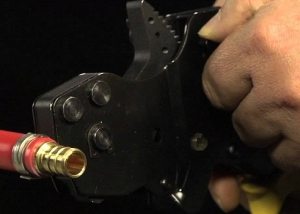Cross-linked polyethylene and pipes made of it are a relatively new type of material and sanitary equipment. It was invented in the twentieth century, but has already managed to become very popular. This is due to significant advantages compared to metal analogues and products from other types of plastic. Before using it at home, you should familiarize yourself with the main features of the product and proceed from the type of communication systems for which it is planned to be used.
Content
What is a cross-linked polyethylene pipe
Embroidered polyethylene pipes have significant advantages that distinguish them against the background of analogues from other types of plastics and metals.
The finished pipe consists of several layers:
- outer layer of polyethylene;
- glue;
- oxygen barrier;
- another layer of adhesive;
- polyethylene inner coating.
An important characteristic of the product is the degree of crosslinking. It ranges from 65% to 85%. The term and quality of pipeline service, as well as the cost of equipment, depend on this indicator.
The indicator itself depends on the production methodology and the quality of work of the manufacturer.
Helpful advice! Usually quality can be judged based on price. Do not try to save on pipes, otherwise it can result in breakdown, and, as a result, even greater costs of finance and time.
In addition, stress and elongation at break, as well as the proportion of the substance in crystalline form, are of great importance.
How is it made and where is it applied
The material itself is characterized by increased strength and durability. The main stage of production is stitching. It can be chemical or physical and is carried out according to 4 main technologies:
- Nitrogen, almost no longer used in our time.
- Electronic - through the introduction of electrons.
- Peroxide, which is the heating of the workpiece using peroxides.
- Silane - treatment in a humid environment enriched with organosilanides and a catalyst.
During this process, no matter what method the manufacturer uses, cross-links between the molecules are formed. The result is a three-dimensional grid with wide cells, which is already a finished material.
Elements of communication systems are made from this raw material. They are used in many sectors of household and economic activity. Most often, this is laying heating systems (for example, underfloor heating) or plumbing for hot and cold water.

PEX pipe is very flexible, it allows you to mount systems with a large number of bends from it without the use of angular connecting elements
For industrial purposes, cross-linked polyethylene pipes are usually not used due to their relatively expensive cost and diameter restrictions.
Pros and cons of the product
Before installing such parts, familiarize yourself with some of the limitations and disadvantages:
- The first, and probably the most significant, is vulnerability to ultraviolet light. Therefore, the pipeline of polyethylene is laid in a hidden way.
- This material is oxygen permeable.True, to a small extent, but this negatively affects the operational characteristics of the product, as it contributes to the development of destructive processes.
- Cross-linked polyethylene pipes produce only small diameters. Due to technical and financial reasons - high production costs and inconvenience, such communications are not issued in large quantities. This affects the versatility of plumbing - they are not used in certain types of systems.
Some pipe models are made with the addition of an additional protective layer. Such an improvement affects the cost of equipment, so when buying, pay attention to the price.

Due to the nature of the technology for the production of cross-linked polyethylene pipes, only small diameters are produced
However, the advantages of this type of communication are much greater:
- resistance to extreme temperatures. Such pipes are able to maintain performance even at very high temperature conditions or in cold weather. The plastic pipeline functions normally even at 100 degrees of heat;
- flexibility. Due to the plasticity of the material, communications can be laid even in the most inaccessible places;
- durability. Pipes made of cross-linked polyethylene can last about 50 years with proper installation and maintenance;
- simplicity at installation and service. Plastic piping systems have an extremely simple design. Smooth walls prevent sedimentation and blockage of pipes;
- light weight. This advantage provides simplicity during transportation and handling of material - transportation is cheaper and it is much easier to move such pipes than, for example, steel pipes.
Mounting Features
To ensure that the pipeline is operational and lasts a long time, it is important not only to choose the right materials, but also to use them correctly. To do this, clearly follow the instructions for the installation of polyethylene communications.
The installation procedure is as follows:
- first you need to cut the pipes into convenient lengths of the desired length;
- the next stage is the calibration of the pipes;
- fit the connecting ring on the workpiece;
- connect the resulting segments into a system. For this, a press is usually used.
Helpful advice! Try to cut carefully so that there are no burrs or jagged edges. Otherwise, the connection will be leaky.
The installation procedure is not complicated and will not cause difficulties even for a novice plumber. If everything is done efficiently and correctly, then such a pipeline will serve you for more than a dozen years with virtually no damage. But the main thing is to be careful and choose good materials, because such systems should be durable.








